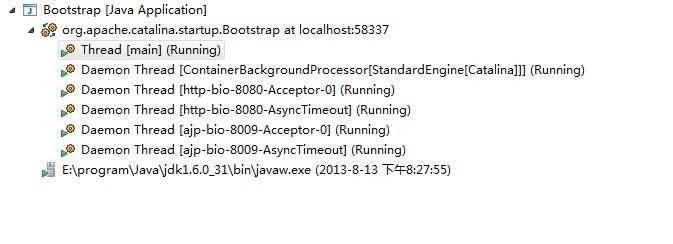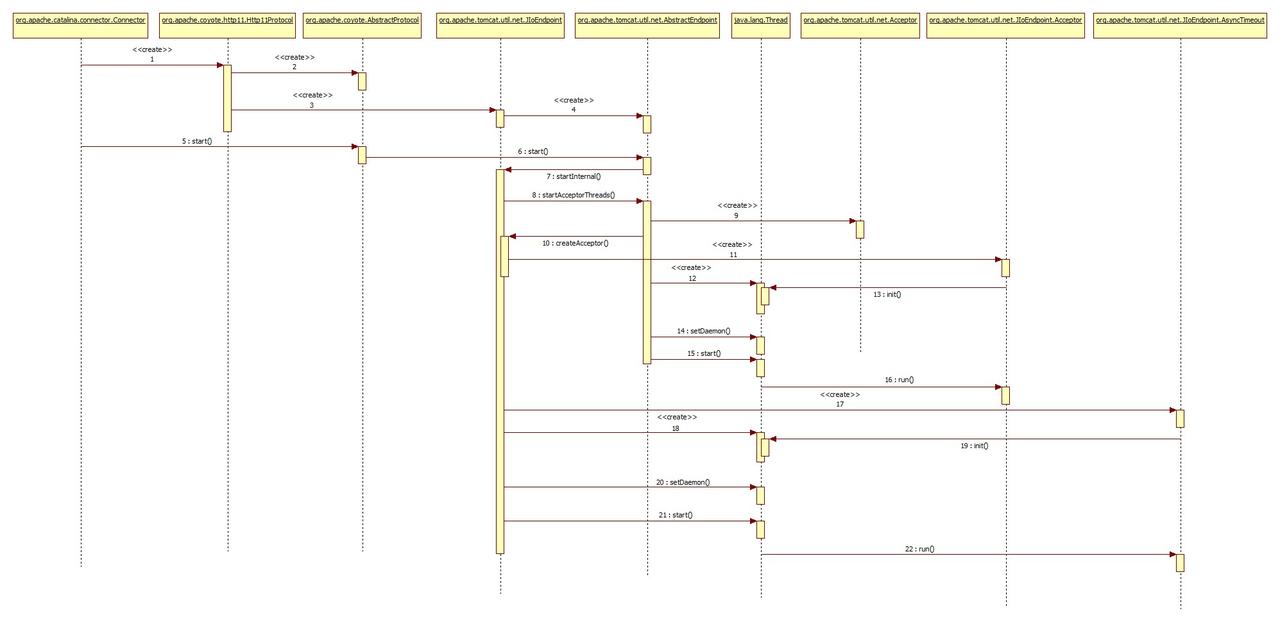在默认的配置下Tomcat启动好之后会看到后台上总共有6个线程在运行。其中1个用户线程,剩下5个为守护线程(如下图所示)。
 如果你对用户线程、守护线程等概念不熟悉,请参看前一篇文章—— Tomcat 7 服务器关闭原理。 这里重点关注以 http-bio-8080 开头的两个守护线程(即 http-bio-8080-Acceptor-0 和 http-bio-8080-AsyncTimeout ),因为这是我们在 Tomcat 的默认配置下 web 应用时实际处理请求的线程。先看下这两个线程在容器启动时是如何产生和启动的。
如果你对用户线程、守护线程等概念不熟悉,请参看前一篇文章—— Tomcat 7 服务器关闭原理。 这里重点关注以 http-bio-8080 开头的两个守护线程(即 http-bio-8080-Acceptor-0 和 http-bio-8080-AsyncTimeout ),因为这是我们在 Tomcat 的默认配置下 web 应用时实际处理请求的线程。先看下这两个线程在容器启动时是如何产生和启动的。
在前面将 Tomcat 启动的系列文章中看到 Tomcat 容器启动时会用 Digester 读取 server.xml 文件产生相应的组件对象并采取链式调用的方式调用它们的 init 和 start 方法,在 Digester 读取到 server.xml 中的 connector 节点时是这么处理的:
digester.addRule("Server/Service/Connector",
new ConnectorCreateRule());
digester.addRule("Server/Service/Connector",
new SetAllPropertiesRule(new String[]{"executor"}));
digester.addSetNext("Server/Service/Connector",
"addConnector",
"org.apache.catalina.connector.Connector");
以上代码见org.apache.catalina.startup.Catalina类的 366 到 372 行。所以在碰到 server.xml 文件中的 Server/Service/Connector 节点时将会触发 ConnectorCreateRule 类的 begin 方法的调用:
1 public void begin(String namespace, String name, Attributes attributes)
2 throws Exception {
3 Service svc = (Service)digester.peek();
4 Executor ex = null;
5 if ( attributes.getValue("executor")!=null ) {
6 ex = svc.getExecutor(attributes.getValue("executor"));
7 }
8 Connector con = new Connector(attributes.getValue("protocol"));
9 if ( ex != null ) _setExecutor(con,ex);
10
11 digester.push(con);
12 }
在第 8 行,会根据配置文件中 Server/Service/Connector 节点的 protocol 属性调用 org.apache.catalina.connector.Connector 类的构造方法,而默认情况下 server.xml 文件中 Server/Service/Connector 节点共有两处配置:
<Connector port="8080" protocol="HTTP/1.1"
connectionTimeout="20000"
redirectPort="8443" />
<Connector port="8009" protocol="AJP/1.3" redirectPort="8443" />
先看第一个 Connector 节点,调用 Connector 的构造方法时会传入字符串 HTTP/1.1
1 public Connector(String protocol) {
2 setProtocol(protocol);
3 // Instantiate protocol handler
4 try {
5 Class<?> clazz = Class.forName(protocolHandlerClassName);
6 this.protocolHandler = (ProtocolHandler) clazz.newInstance();
7 } catch (Exception e) {
8 log.error(sm.getString(
9 "coyoteConnector.protocolHandlerInstantiationFailed"), e);
10 }
11 }
这里先会执行 org.apache.catalina.connector.Connector 类的 setProtocol 方法:
1 public void setProtocol(String protocol) {
2
3 if (AprLifecycleListener.isAprAvailable()) {
4 if ("HTTP/1.1".equals(protocol)) {
5 setProtocolHandlerClassName
6 ("org.apache.coyote.http11.Http11AprProtocol");
7 } else if ("AJP/1.3".equals(protocol)) {
8 setProtocolHandlerClassName
9 ("org.apache.coyote.ajp.AjpAprProtocol");
10 } else if (protocol != null) {
11 setProtocolHandlerClassName(protocol);
12 } else {
13 setProtocolHandlerClassName
14 ("org.apache.coyote.http11.Http11AprProtocol");
15 }
16 } else {
17 if ("HTTP/1.1".equals(protocol)) {
18 setProtocolHandlerClassName
19 ("org.apache.coyote.http11.Http11Protocol");
20 } else if ("AJP/1.3".equals(protocol)) {
21 setProtocolHandlerClassName
22 ("org.apache.coyote.ajp.AjpProtocol");
23 } else if (protocol != null) {
24 setProtocolHandlerClassName(protocol);
25 }
26 }
27
28 }
所以此时会调用setProtocolHandlerClassName("org.apache.coyote.http11.Http11Protocol")从而将 Connector 类实例变量 protocolHandlerClassName 值设置为org.apache.coyote.http11.Http11Protocol,接下来在 Connector 的构造方法中就会根据 protocolHandlerClassName 变量的值产生一个org.apache.coyote.http11.Http11Protocol对象,并将该对象赋值给 Connector 类的实例变量 protocolHandler 。在 Http11Protocol 类的构造方法中会产生一个org.apache.tomcat.util.net.JIoEndpoint对象:
1 public Http11Protocol() {
2 endpoint = new JIoEndpoint();
3 cHandler = new Http11ConnectionHandler(this);
4 ((JIoEndpoint) endpoint).setHandler(cHandler);
5 setSoLinger(Constants.DEFAULT_CONNECTION_LINGER);
6 setSoTimeout(Constants.DEFAULT_CONNECTION_TIMEOUT);
7 setTcpNoDelay(Constants.DEFAULT_TCP_NO_DELAY);
8 }
几个相关对象的构造方法调用时序图如下所示,其中org.apache.coyote.AbstractProtocol是org.apache.coyote.http11.Http11Protocol的父类org.apache.tomcat.util.net.AbstractEndpoint是org.apache.tomcat.util.net.JIoEndpoint的父类。
 接下来容器启动各组件时会调用
接下来容器启动各组件时会调用 org.apache.catalina.connector.Connector的 start 方法,如前面分析 Tomcat 启动时所述,此时会调用 org.apache.catalina.connector.Connector类的 startInternal 方法:
protected void startInternal() throws LifecycleException {
// Validate settings before starting
if (getPort() < 0) {
throw new LifecycleException(sm.getString(
"coyoteConnector.invalidPort", Integer.valueOf(getPort())));
}
setState(LifecycleState.STARTING);
try {
protocolHandler.start();
} catch (Exception e) {
String errPrefix = "";
if(this.service != null) {
errPrefix += "service.getName(): \"" + this.service.getName() + "\"; ";
}
throw new LifecycleException
(errPrefix + " " + sm.getString
("coyoteConnector.protocolHandlerStartFailed"), e);
}
mapperListener.start();
}
在第 12 行,将会调用实例变量 protocolHandler 的 start 方法。在上面分析 Connector 类的构造函数时发现 protocolHandler 变量的值就是org.apache.coyote.http11.Http11Protocol对象,所以此时将会调用该类的 start 方法。在 Http11Protocol 类中没有定义 start 方法,这里将会调用其父类org.apache.coyote.AbstractProtocol中的 start 方法:
public void start() throws Exception {
if (getLog().isInfoEnabled())
getLog().info(sm.getString("abstractProtocolHandler.start",
getName()));
try {
endpoint.start();
} catch (Exception ex) {
getLog().error(sm.getString("abstractProtocolHandler.startError",
getName()), ex);
throw ex;
}
}
这里会调用 endpoint 对象的 start 方法,而 endpoint 是org.apache.tomcat.util.net.JIoEndpoint类的实例(在上面讲 Http11Protocol 类的构造方法时所提到),这里最终会执行该类的 startInternal 方法:
1 @Override
2 public void startInternal() throws Exception {
3
4 if (!running) {
5 running = true;
6 paused = false;
7
8 // Create worker collection
9 if (getExecutor() == null) {
10 createExecutor();
11 }
12
13 initializeConnectionLatch();
14
15 startAcceptorThreads();
16
17 // Start async timeout thread
18 Thread timeoutThread = new Thread(new AsyncTimeout(),
19 getName() + "-AsyncTimeout");
20 timeoutThread.setPriority(threadPriority);
21 timeoutThread.setDaemon(true);
22 timeoutThread.start();
23 }
24 }
正是在这里产生并启动本文开头提到的 http-bio-8080-Acceptor-0 和 http-bio-8080-AsyncTimeout 两个线程。第 17 到 22 行就是产生和启动 http-bio-8080-AsyncTimeout 线程,第 15 行这里调用父类org.apache.tomcat.util.net.AbstractEndpoint的 startAcceptorThreads 方法:
1 protected final void startAcceptorThreads() {
2 int count = getAcceptorThreadCount();
3 acceptors = new Acceptor[count];
4
5 for (int i = 0; i < count; i++) {
6 acceptors[i] = createAcceptor();
7 String threadName = getName() + "-Acceptor-" + i;
8 acceptors[i].setThreadName(threadName);
9 Thread t = new Thread(acceptors[i], threadName);
10 t.setPriority(getAcceptorThreadPriority());
11 t.setDaemon(getDaemon());
12 t.start();
13 }
14 }
15
16
17 /**
18 * Hook to allow Endpoints to provide a specific Acceptor implementation.
19 */
20 protected abstract Acceptor createAcceptor();
在这里将产生和启动 http-bio-8080-Acceptor-0 线程。注意在构造该线程时第 6 行将会调用第 20 行的抽象方法,该方法的具体实现是在 JIoEndpoint 类中:
@Override
protected AbstractEndpoint.Acceptor createAcceptor() {
return new Acceptor();
}
以上便是本文开头所述的两个后台线程产生和启动的流程,其相关类调用的时序图如下图所示:
 同理,ajp-bio-8009-Acceptor-0 和 ajp-bio-8009-AsyncTimeout 两个守护线程的产生和启动方式也是一致的,不再赘述。
同理,ajp-bio-8009-Acceptor-0 和 ajp-bio-8009-AsyncTimeout 两个守护线程的产生和启动方式也是一致的,不再赘述。